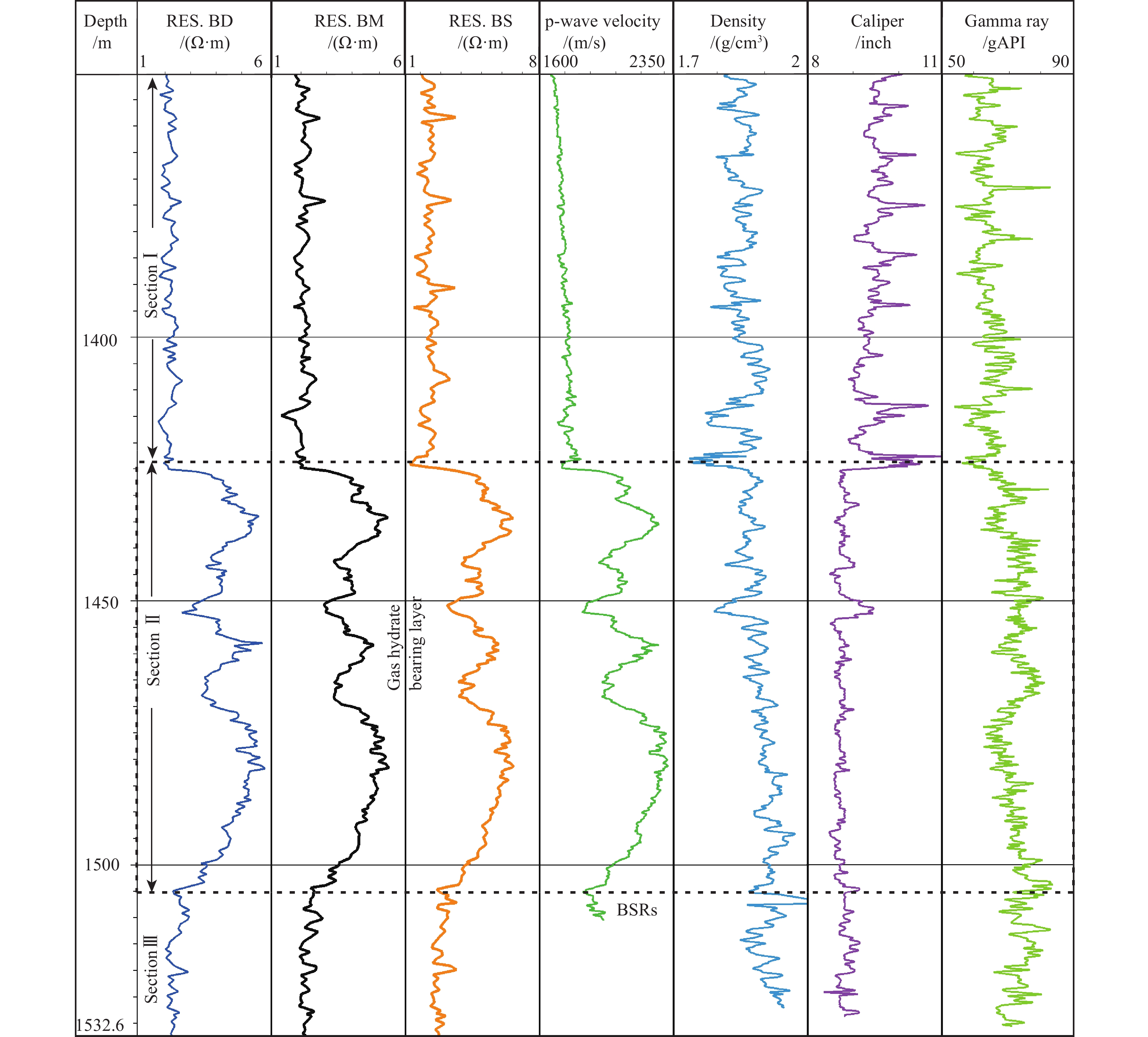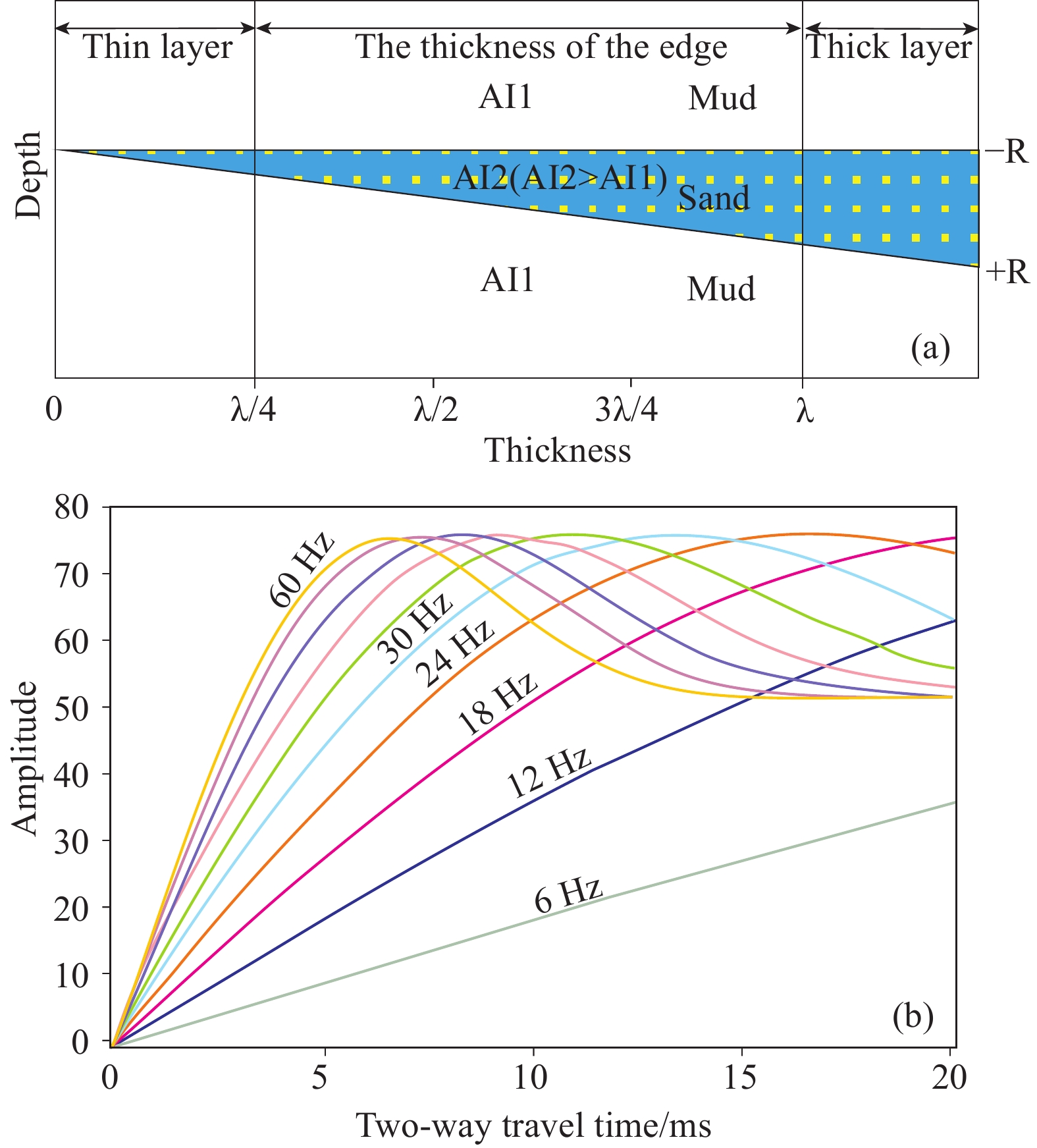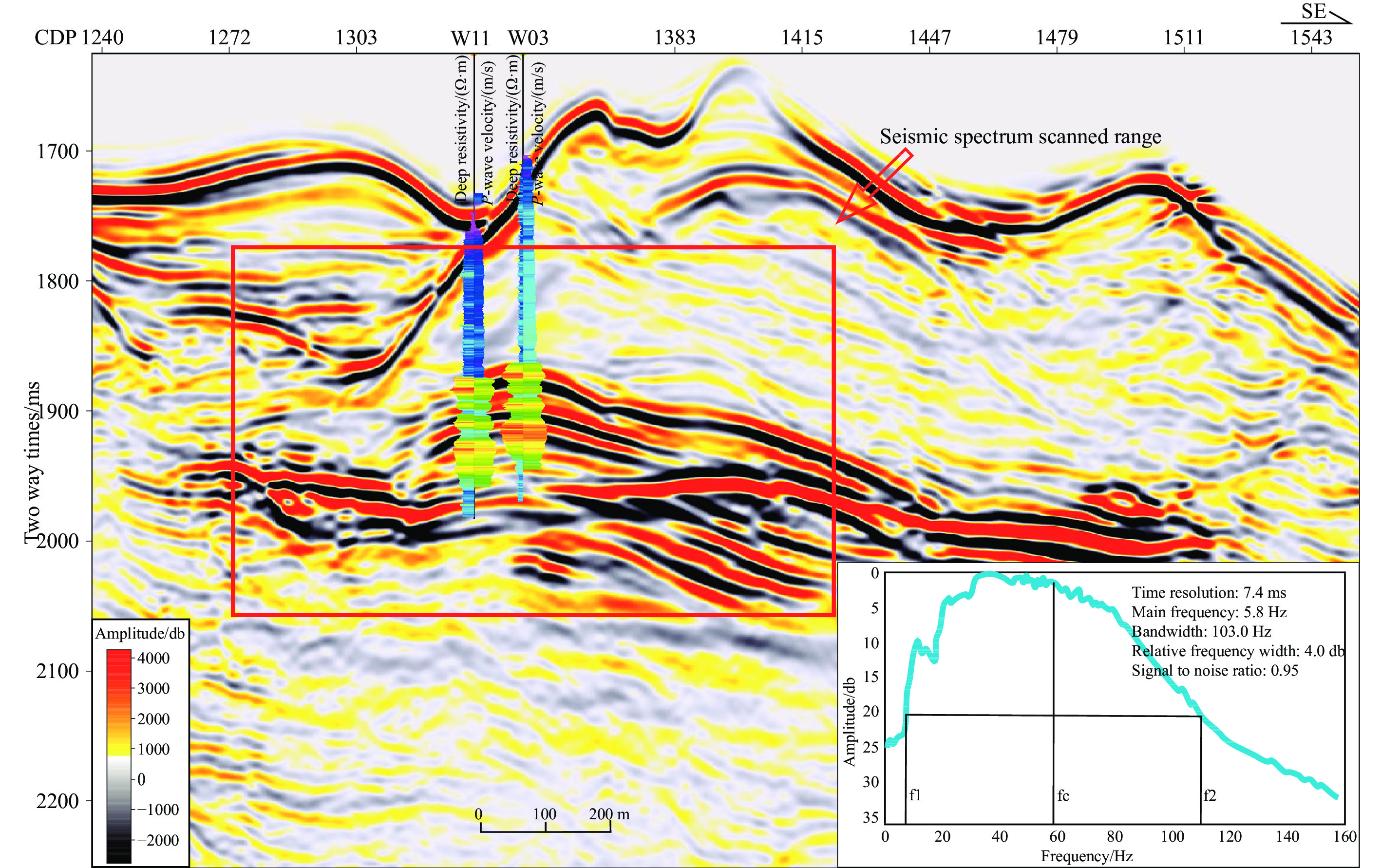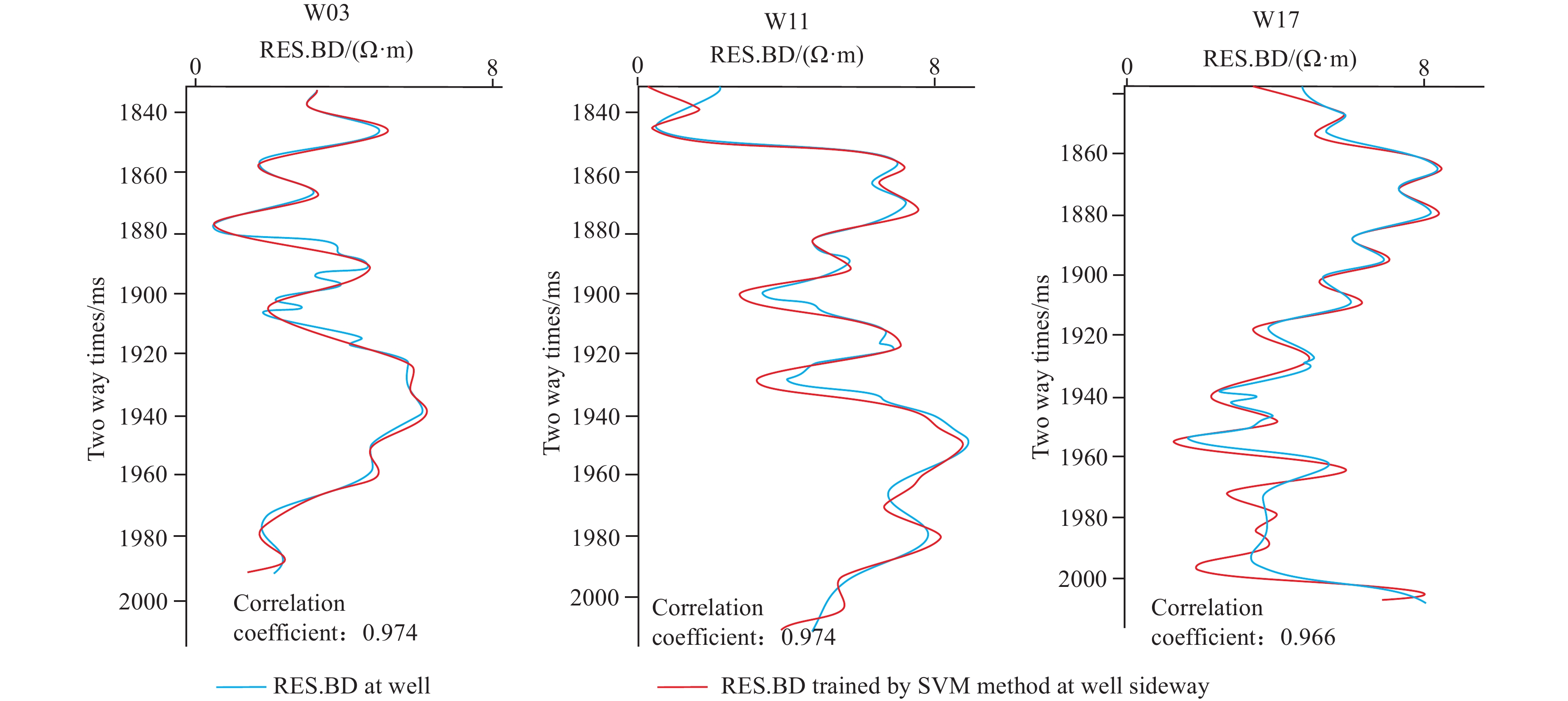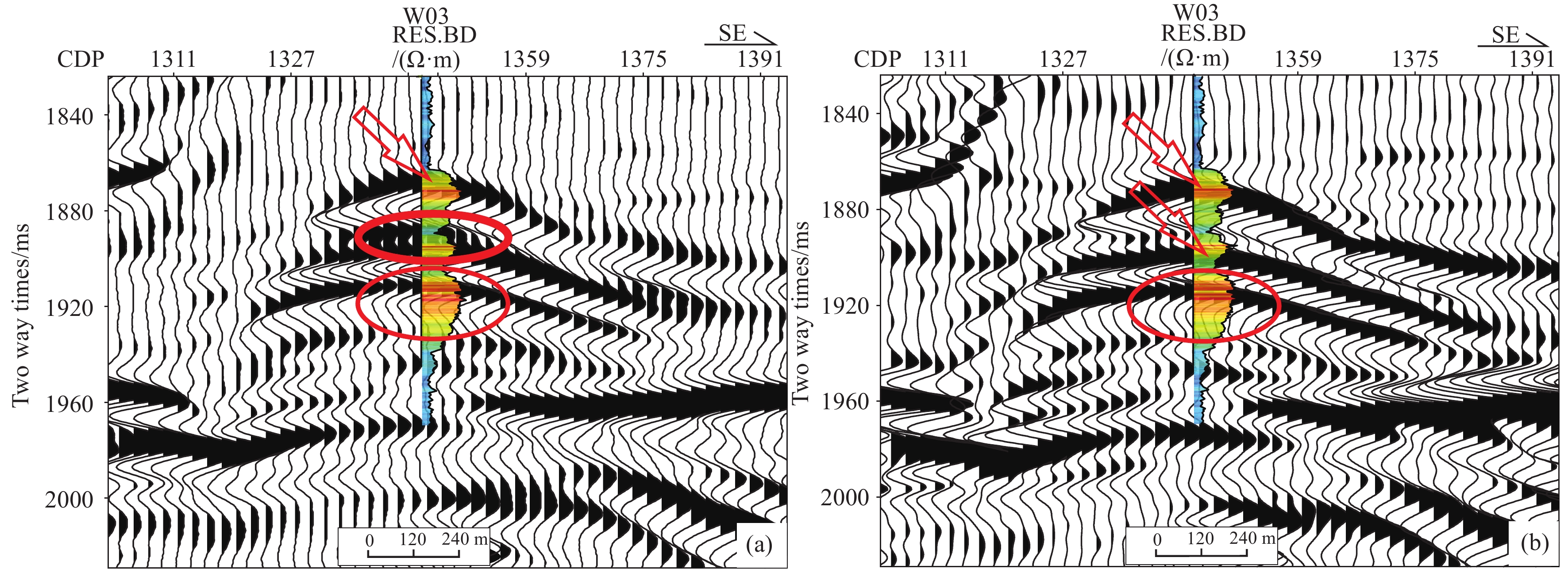| Citation: | Shu-yu Wu, Jun Liu, Hua-ning Xu, Chang-ling Liu, Fu-long Ning, Hong-xian Chu, Hao-ran Wu, Kai Wang, 2022. Application of frequency division inversion in the prediction of heterogeneous natural gas hydrates reservoirs in the Shenhu Area, South China Sea, China Geology, 5, 251-266. doi: 10.31035/cg2021074 |
Application of frequency division inversion in the prediction of heterogeneous natural gas hydrates reservoirs in the Shenhu Area, South China Sea
-
Abstract
Drilling results suggest that the thickness of natural gas hydrates (NGHs) in the Shenhu Area, South China Sea (SCS) are spatially heterogenous, making it difficult to accurately assess the NGHs resources in this area. In the case that free gas exists beneath hydrate deposits, the frequency of the hydrate deposits will be noticeably attenuated, with the attenuation degree mainly affected by pore development and free gas content. Therefore, the frequency can be used as an important attribute to identify hydrate reservoirs. Based on the time-frequency characteristics of deposits, this study predicted the spatial distribution of hydrates in this area using the frequency division inversion method as follows. Firstly, the support vector machine (SVM) method was employed to study the amplitude versus frequency (AVF) response based on seismic and well logging data. Afterward, the AVF response was introduced as independent information to establish the nonlinear relationship between logging data and seismic waveform. Then, the full frequency band information of the seismic data was fully utilized to obtain the results of frequency division inversion. The inversion results can effectively broaden the frequency band, reflect the NGHs distribution, and reveal the NGHs reservoirs of two types, namely the fluid migration pathway type and the in situ self-generation self-storage diffusion type. Moreover, the inversion results well coincide with the drilling results. Therefore, it is feasible to use the frequency division inversion to predict the spatial distribution of heterogeneous NGHs reservoirs, which facilitates the optimization of favorable drilling targets and is crucial to the resource potential assessment of NGHs.
-

-
References
Chen ZG, Sun X, Liu LS, Guo ZH, Ma H, Nie G. 2018. Application of frequency division inversion of low frequency seismic data in middle block of Caspian Basin. Oil Geophysical Prospecting, 53, 261–265 (in Chinese with English abstract). Collett TS, Ladd J. 2000. Detection of gas hydrate with downhole logs and assessment of gas hydrate concentrations (saturations) and gas volumes on the Blake Ridge with electrical resistivity log data. Proceeding of the Ocean Drilling Programme, Scientific Results, 164, 179‒191. doi: 10.2973/odp.proc.sr.164.219.2000. Feng D, Chen DF. 2015. Authigenic carbonates from an active cold seep of the Northern South China Sea: New insights into sources and past seepage activity. Deep-sea Research II, 122, 74–83. doi: 10.1016/j.dsr2.2015.02.003. Gao L, Jiang T, Wang MC, Chen WX, Qing T. 2018. Reservoir prediction of “rich san” shallow delta and hydrocarbon accumulation pattern analysis−A case of shaleitian salient lower member of Minghuazhen in the western Bohai Sea. Computing techniques for Geophysical and Geochemical Exploration, 40(1), 27–35 (in Chinese with English abstract). Gong HL, Wang Z, Cai G, Li S. 2007. Application of separate frequency interpretation technique in prediction of carbonate reservoir. Journal of Southwest Petroleum University, 29(S1), 5–9 (in Chinese with English abstract). Gong YH, Yang SX, Wang HB, Liang JQ, Guo YQ, Wu SG, Liu GH. 2009. Gas hydrate reservoir characteristics of Shenhu area, North slope of the South China Sea. Geoscience, 23(2), 210–216 (in Chinese with English abstract). Gong YH, Wu SG, Zhang GX, Wang HB, Liang JQ, Guo YQ, Sha ZB. 2008. Relation between gas hydrate and geologic structures in Dongsha islands Sea area of South China Sea. Marine Geology and Quaternary Geology. 28(1), 99–104 (in Chinese with English abstract). doi: 10.16562/j.cnki.025-1492.2008.01.013. Hardage BA, Roberts HH. 2006. Gas hydrate in the Gulf of Mexico: What and where is the seismic target? Leading edge (Tulsa, Okla ), 25(5), 566–571. doi: 10.1190/1.2202660. He JX, Lu ZQ, Su PB, Zhang W, Feng JX. 2016. Source supply system and reservoir forming model prediction of natural gas hydrate in the deep water area of the Northern South China Sea. Journal of Southwest Petroleum University (Science & Technology Edition), 38(6), 8–24 (in Chinese with English abstract). doi: 10.11885/j.issn.16745086.2016.09.03.01. Huang LJ, Pan JG, Huang Y, Guo JJ, Cai G, Wang YJ, Zhang H. 2012. Application of frequency-divided inversion of thin sand layer prediction of ancient valley reservoir in XIQ area of Eastern Jungar Basin. Journal of Oil and Gas Technology, 34(11), 52–55 (in Chinese with English abstract). doi: 10.3969/j.issn.1000-9752.2012.11.011. Ji YX, Liu CY, Chen D, Wang KN. 2010. Frequency-divided inversion and its application to reservoir prediction in block A of Tahe Oilfield. Oil & Gas Geology, 31(1), 38–42 (in Chinese with English abstract). doi: 10.1016/S1876-3804(11)60008-6. Jin JP, Wang XJ, Chen DX, Guo YQ, Su PB, Liang JQ, Qian J. 2017. Distribution of gas hydrate in Shenhu area: Identified with well log and seismic multi-attributes. Marine Geology and Quaternary Geology, 37(5), 122–130 (in Chinese with English abstract). doi: 10.16562/j.cnki.026-1492.2017.05.012. Khlebnikov VN, Antonovs V, Mishina S, Liang M, Khamidullinai V, Zobovp M, Likhachevan V, Gushchinp A. 2017. Major factors influencing the formation of natural gas hydrates in porous media. Natural Gas Industry, 37(5), 38–45 (in Chinese with English abstract). doi: 10.3787/j.issn.1000-0976.2017.05.005. Li JF, Ye JL, Qin XW, Qiu HJ, Wu NY, Lu HL, Xie WW, Lu JA, Peng F, Xu ZQ, Lu C, Kuang ZG, Wei JG, Liang QY, Lu HF, Kou BB. 2018. The first offshore natural gas hydrate production test in South China Sea. China Geology, 1(1), 5–16. doi: 10.31035/cg2018003. Li JH, Liu J, Zhang JZ, Sun YB, Zhao TH. 2015. Delineation of natural gas hydrate reservoirs in Shenhu area of South China Sea using seismic spectral inversion technique. Marine geology frontiers, 31(6), 55–62 (in Chinese with English abstract). Li XY, Li XS, Wang Y, Liu JW, Hu HQ. 2021. The optimization mechanism for gas hydrate dissociation by depressurization in the sediment with different water saturations and different particle sizes. Energy, 215, 119–129. doi: 10.1016/j.energy.2020.119129. Liang JQ, Zhang GX, Lu J, Su PB, Sha ZB, Gong YH, Su X. 2016. Accumulation characteristics and genetic models of natural gas hydrate reservoirs in the NE slope of the South China Sea. Natural Gas, 36(10), 157–162 (in Chinese with English abstract). doi: 10.3787/j.issn.1000-0976.2016.10.020. Liu J, Zhang JZ, Sun YB, Zhao TH. 2016. Seismic velocity estimation method based on spectral inversion. Oil Geophysical Prospecting, 51(5), 909–915 (in Chinese with English abstract). Liu J. 2008. The Integrated Geophysical Study of Baiyun Sag and Its Peripheral Areas of the Pearl River Mouth Basin in South China Sea. Hangzhou, Second institution of Oceanography, Master thesis, 6‒9 (in Chinese with English abstract). Liu J, Wu SY, Chen JW, Xiao GL, Gao JY. 2017. Classic thin sandbody reservoir identification technique and its application in the North Yellow Sea Basin. Progress in Geophysics, 32(3), 1384–1392 (in Chinese with English abstract). doi: 10.6038/pg20170358. Liu TT, Tong SY, Han LG. 2017. Seismic attribute extraction of marine gas hydrate. Global Geology, 36(4), 1244–1251 (in Chinese with English abstract). Liu XW, Li MF, Zhang YW, Zhang GX, Wu NY, Huang YY, Wang HB. 2005. Studies of seismic characteristics about gas hydrate: A case study of line HD152 in the South China Sea. Geoscience, 19(1), 33–38 (in Chinese with English abstract). Liu YJ, Liu XW, Liu DM, Zhao YX. 2007. Application of geophysical techniques to gas hydrate prediction. Petroleum Exploration and Development, 34(5), 566–573 (in Chinese with English abstract). Lu SM, Mcmechan GA. 2004. Elastic impedance inversion of multichannel seismic data from unconsolidated sediments containing gas hydrate and free gas. Geophysics, 69(1), 164–179. doi: 10.1190/1.1649385. Lu YT, Luan XW, Lü F, Wang B, Yang ZL, Yang T, Yao GS. 2017. Seismic evidence and formation mechanism of gas hydrates in the Zhongjiannan Basin, Western margin of the South China Sea. Marine and Petroleum Geology, 84, 274–288. doi: 10.1016/j.marpetgeo.2017.04.005. Lü L, Wang MJ, Fan JZ. 2011. Seismic attribute recognition in the application of natural gas hydrate. Progress in Geophysics, 26(2), 596–601 (in Chinese with English abstract). doi: 10.3969/j.issn.1004-2903.2011.02.026. Ma ZT, Geng JH, Dong LG, Song HB. 2002. Seismic recognition studies on marine gas hydrate. Marine Geology and Quaternary Geology, 22(1), 1–8 (in Chinese with English abstract). doi: 10.16535/j.cnki.0256-1492.2002.01.001. Manzi MSD, Hein KAA, Durrheim R, King N. 2013. Seismic attribute analysis to enhance detection of thin gold-bearing reefs: South deep gold mine, Witwatersrand basin, South Africa. Journal of Applied Geophysics, 98, 212–228. doi: 10.1016/j.jappgeo.2013.08.017. Milkov AV, Sassen R. 2000. Thickness of the gas hydrate stability zone, Gulf of Mexico continental slope. Marine and Petroleum Geology, 17(9), 981–991. doi: 10.1016/S0264-8172(00)00051-9. Minshull TA, Singh SC, Westbrook GK. 1994. Seismic velocity structure at a gas hydrate reflector, offshore western Colombia, from full waveform inversion. Journal of Geophysical Research: Solid Earth, 99(B3), 4715–4734. doi: 10.1029/93JB03282. Molet J, Arensz G, Fourgeau E, Giard D. 1982. Wave propagation and sampling theory-Part I: Complex signal and scattering in multilayered media. Geophysics, 47(2), 203–221. doi: 10.1190/1.1441328. Partyka G, Gridley J, Lopez J. 1999. Interpretational applications of spectral decomposition in reservoir characterization. The Leading Edge, 18(3), 353–360. doi: 10.1190/1.1438295. Pecher IA, Minshull TA, Singh SC, Huene RV. 1996. Velocity structure of a bottom simulating reflector offshore Peru: Results from full waveform inversion. Earth and Planetary Science letters, 139, 459–469. doi: 10.1016/0012-821X(95)00242-5. Qian J, Wang XJ, Dong DD, Wu SG, Kalachand S, Ye YM. 2016. Quantitative assessment of free gas beneath gas hydrate stability zone from prestack seismic data and rock physics: A case of hole NGHP01-10A, Krishna-Godavari basin, India. Chinese Journal of Geophysics, 59(7), 2553–2563 (in Chinese with English abstract). doi: 10.6038/cjg20160720. Qin XW, Zhao B, Li FY, Zhang BJ, Wang HJ, Zhang RW, He JX, Chen X. 2019. Deep structural research of the South China Sea: Progresses and directions. China Geology, 3(4), 533–543. doi: 10.31035/ cg2018125. Ren H, Goloshubin G, Hilterman FJ. 2009. Poroelastic analysis of permeability effects in thinly layered porous media. Geophysics, 74(6), 49–54. doi: 10.1190/1.3223185. Riedel M, Shankar U. 2012. Combining impedance inversion and seismic similarity for robust gas hydrate concentration assessments–A case study from the Krishna–Godavari basin, East Coast of India. Marine and Petroleum Geology, 36(1), 35–49. doi: 10.1016/j. marpetgeo.2012.06.006. Rossi G, Gei D, B Hohm G, Madrussani G, Carcione JM. 2007. Attenuation tomography: An application to gas-hydrate and free-gas detection, 55(5), 655‒669. doi: 10.1111/j.1365-2478.2007.00646.x. Ruan AG, Li JB, Chu FY, Li XY. 2006. AVO numerical simulation of gas hydrates reflectors beneath seafloor. Chinese Journal of Geophysics, 49(6), 1826–1835 (in Chinese with English abstract). Sha ZB, Gong YH, Liang JQ. 2006. How to judge gas hydrates seismic character from the different kinds of attribute profile. Geological South China Sea, (1), 105–113 (in Chinese with English abstract). Sha ZB, Zheng T, Yang MZ, Wang MJ, Liang JQ, Su PB, Chen XY. 2010. The seismic detecting technique on gas hydrates based on wave impedance inversion. Geoscience, 24(3), 481–488 (in Chinese with English abstract). Sha ZB, Liang JQ, Su PB, Zhang GX, Lu J, Wang J. 2015. Natural gas hydrate accumulation elements and drilling results analysis in the Eastern part of the Pearl River Mouth Basin. Earth science frontiers, 22(6), 125–135 (in Chinese with English abstract). doi: 10.13745/j.esf.2015.06.009. Shankar U, Riedel M. 2010. Seismic and heat flow constraints from the gas hydrate system in the Krishna-Godavari Basin, India. Marine Geology, 276(1‒4), 1‒13. doi: 10.1016/j.margeo.2010.06.006. Song HB, Osamu M, Kuramoto S. 2003. Full waveform inversion of gas hydrate-related bottom simulating reflectors. Chinese Journal of Geophysics, 46(1), 42–46 (in Chinese with English abstract). Song HB, Song LX, Yang SX, Jiang WW. 2001, Geophysical researches on marine gas hydrates (II): Seismic methods. Progress in Geophysics, 16(3), 110‒118 (in Chinese with English abstract). doi: 10.3969/j.issn.1004-2903.2001.03.015. Song HB, Matsubayashi O, Yang SX, Wu NY, Jiang WW, Hao TY. 2002. Physical property models of gas hydrate-bearing sediments and AVA character of bottom simulating reflector. Chinese Journal of Geophysics, 45(4), 569–579. doi: 10.1002/cjg2.270. Su PB, Lei HY, Liang JQ, Sha ZB, Liang J. 2010. Geophysical anomaly characteristics of gas hydrate zone in Northern South China Sea. Xinjiang Petroleum Geology, 31(5), 485–488 (in Chinese with English abstract). Su PB, Liang JQ, Zhang ZJ, Sha ZB. 2017. Analysis on the bright spots and dim out of seismic section for diffusion-type hydrate in Shenhu area. Earth Science Frontiers, 24(4), 51–56 (in Chinese with English abstract). doi: 10.13745/j.esf.yx.2016-12-29. Su PB, Liang JQ, Sha ZB, Fu SY. 2014. Gas sources condition of gas hydrate formation in Shenhu deep water sea zone. Journal of Southwest Petroleum University (Science & Technology Edition), 36(2), 1–8 (in Chinese with English abstract). doi: 10.11885/j.issn.1674-5086.2013.10.16.01. Sun YB, Zhao TH, Qin K, Feng J. 2015. Time-freqency- based thickness estimation of hydrate-bearing layer in the Shenhu area of the South China Sea. Journal of Tropical Oceanography, 34(3), 54–61 (in Chinese with English abstract). doi: 10.3969/j.issn.1009-5470.2015.03.007. Sun Z, Pang X, Zhong ZH, Zhou D, Chen CM, Hao HJ, He M, Huang CJ, Xu H. 2005. Dunamics of tertiary tectonic evolution of the Baiyun Sag in the Pearl River Mouth Basin. Earth science frontiers (China University of Geosciences, Beijing; Peking University), 12(4), 489‒498 (in Chinese with English abstract). doi: 10.3321/j.issn:1005-2321.2005.04.018. Vapnik VN, Chervonenkis AY. 1971. Chervonenkis: On the uniform convergence of relative frequencies of events to their probabilities. Theory of Probability and Its Applications, XVI(2), 264–280. doi: 10.1007/978-3-319-21852-6_3. Wang B, Niu C, Li Y, Huang R, Chen LX, Ye Y. 2019. Application of frequency division inversion based on generalized S transform in oil and gas exploration in deep water area of South China Sea. Progress in Geophysics, 34(6), 2508–2514 (in Chinese with English abstract). doi: 10.6038/pg2019CC0439. Wang HB, Zhang GX, Yang MZ, Liang JQ, Liang J, Zhong GJ. 2003. Structural circumstance of gas hydrate deposition in the continent margin, the South China Sea. Marine Geology and Quaternary Geology, 23(1), 81–86 (in Chinese with English abstract). doi: 10.16562/j.cnki.0256-1492.2003.01.013. Wang JL, Liang JQ, Zong X, Gong YH, Wan TH. 2015. Differentiated distribution of methane hydrate in the Shenhu area of the Northern South China Sea and controlling factors. Marine Geology Frontiers, 31(1), 24–30 (in Chinese with English abstract). doi: 10.16028/j.1009-2722.2015.01004. Wang KN. 2010. The Research of High-resolution Post-stack Inversion Methods and Application in Tahe Oil Field. Peking, China University of Geoscience, Ph.D thesis, 14‒22 (in Chinese with English abstract). Wang XC, Pan D. 2017. Application of AVO attribute inversion technology to gas hydrate identification in the Shenhu Area, South China Sea. Marine and Petroleum Geology. 80, 23–31. doi: 10.1016/j.marpetgeo.2016.11.015. Wang ZQ, Wang HB, Zhang HQ, Zhang JJ, Wu XQ. 2014. Frequency-divided inversion for the intraplatform shoal reservoir. Natural Gas Geoscience, 25(11), 1847–1854 (in Chinese with English abstract). doi: 10.11764/j.issn.1672-1926.2014.11.1847. Widess MB. 1973. How thin is a thin bed? Geophysics, 38(6), 117‒1180. doi: 10.1190/1.1440403. Wu NY, Zhang HQ, Yang SX, Liang JQ, Wang HB. 2007. Preliminary discussion on natural gas hydrate (NGH) reservoir system of Shenhu area, North slope of South China Sea. Natural Gas Industry, 27(9), 1–6 (in Chinese with English abstract). doi: 10.3321/j.issn:1000-0976.2007.09.001. Wu NY, Liang JQ, Wang HB, Su X, Song HB, Jiang SY, Zhu YH, Lu ZQ. 2008. Marine gas hydrate system: State of the art. Geoscience, 22(3), 356–362 (in Chinese with English abstract). doi: 10.3969/j.issn.1000-8527.2008.03.003. Wu NY, Yang SX, Wang HB, Liang JQ, Gong YH, Lu ZQ, Wu DD, Guan HX. 2009. Gas-bearing fluid influx sub-system for gas hydrate geological system in Shenhu Area, Northern South China Sea. Chinese Journal of Geophysics. 52(6), 1641–1650 (in Chinese with English abstract). doi: 10.3969/j.issn.0001-5733.2009.06.027. Wu SY, Liu J. 2015. High resolution sequence stratigraphic study basic on time-frequency analysis. Marine Geology and Quaternary Geology, 35(4), 197–207 (in Chinese with English abstract). doi: 10.16562/j.cnki.0256-1492.2015.04.021. Wu SY, Liu J. 2016. Application of time-frequency analysis to the Mesozoic reservoir, eastern depression of north Yellow Sea. Marine Geology and Quaternary Geology, 36(1), 189–196 (in Chinese with English abstract). doi: 10.16562/j.cnki.0256-1492.2016.01.019. Wu SY, Liu J, Xiao GL, Zhang YG, Liang J, Wang JQ. 2017. Thin classic sandbody reservoir predicticon based on Matching pursuit spectrum decomposition- a case of Eastern Depression of North Yellow Sea Basin. Marine Geology and Quaternary Geology, 37(3), 197–207 (in Chinese with English abstract). Xu HN, Lu J, Liang JQ. 2017. Seismic identification and geological origin of gas hydrate in near seafloor sediments in the Eastern Part of the Pearl River Mouth Basin. Earth Sciences Frontiers, 24(4), 57–65 (in Chinese with English abstract). doi: 10.13745/j.esf.yx.2016-12-31. Xu HN, Yang SX, Zheng XD, Wang MJ, Wang JS. 2010. Seismic identification of gas hydrate and its distribution in Shenhu area, South China Sea. Chinese Journal of Geophysics, 53(7), 1691–1698. doi: 10.3969/j.issn.0001-5733.2010.07.020. Xu HN, Zhang GX, Zheng XD, Wang MJ, Yang SX, Yang R, Liang BW. 2014. Integrated analysis of well logs and seismic data to deduce the possible distribution in depth of gas hydrate in Shenhu area, South China Sea. Chinese Journal of Geophysics, 57(10), 3363–3372 (in Chinese with English abstract). doi: 10.6038/cjg20141023. Xu W, Qiu NS, Sun CY, Chen GJ. 2010. The distribution characteristics of the thickness of gas hydrate stability zone in South China Sea. Geoscience, 24(3), 467–473 (in Chinese with English abstract). doi: 10.3969/j.issn.1000-8527.2010.03.008. Xu YX, Zhang BJ, Wen PF. 2016. The application research of high density velocity analysis in hydrate impedance inversion without log constrain. Computing Techniques for Geophysical and Geochemical Exploration, 38(4), 540–545 (in Chinese with English abstract). Xue H, Zhang BJ, Xu YX, Wen PF, Zhang RW. 2016. Application of wave impedance inversion to gas hydrates prediction in Southeast Hainan Basin. Marine Geology and Quaternary Geology, 36(2), 173–180 (in Chinese with English abstract). doi: 10.16562/j.cnki.0256-1492.2016.02.020. Yang R, Wu NY, Lei XH, Liang JQ, Sha ZB, Su Z. 2010. Impedance inversion and its application in gas hydrate exploration in Shenhu area, Northern South China Sea. Geosicence, 24(3), 495‒500. doi: 10.3969/j.issn.1000-8527.2010. 03.012. Yang RZ, Li SN, Wang YY, Li Y, Jie ML, Peng WJ, Li CC, Liang JQ, Sha ZB. 2012. Application of inversion without well constraint to hydrate forecasting in Shenhu area. Natural Gas Geoscience, 23(4), 784–790 (in Chinese with English abstract). Yang SX, Liang JQ, Lu JA, Qu CW, Liu B. 2017. New understanding on the characteristics and controlling factors of gas hydrate reservoir in the Shenhu area on the Northern slope of the South China Sea. Earth Sciences Frontiers, 24(4), 1–14 (in Chinese with English abstract). doi: 10.13745/j.esf.yx.2016-12-43. Yao BC, Yang MZ. 2008. Tectonic movement in the late Cenozoic and gas hydrate resources in the South China Sea. Marine Geology and Quaternary Geology, 28(4), 93–100 (in Chinese with English abstract). doi: 10.3724/sp.j.1140.2008.03093. Ye JL, Qin XW, Qiu HJ, Liang QY, Dong YF, Wei JG, Lu HL, Lu JA, Shi YH, Zhong C, Xia Z. 2018. Preliminary results of environmental monitoring of the natural gas hydrate production test in the South China Sea. China Geology, 1(2), 202–209. doi: 10.31035/cg2018029. Yoo DG, Kang NK, Yi BY, Kim GY, Ryu BJ, Lee K, GH Lee, Riedel M. 2013. Occurrence and seismic characteristics of gas hydrate in the Ulleung Basin, East Sea. Marine and Petroleum Geology, 47, 236–247. doi: 10.1016/j.marpetgeo.2013.07.001. Yu JG, Han WG, Liu LH. 2006. Frequency-divided inversion and application. Oil Geophysical Prospecting, 41(2), 193–197 (in Chinese with English abstract). Yu P, Li ZC. 2006. Application of frequency-divided technique in reservoir prediction. Progress in Exploration Geophysics, 29(6), 419–423 (in Chinese with English abstract). Yu P, Li ZC. 2010. The application of frequency-divided technique in reservoir prediction. Inner Mongolia Petrochemical Technology, (3), 113–115 (in Chinese with English abstract). doi: 10.3969/j.issn.1006-7981.2010.03.056. Yu XH, Wang JZ, Liang JQ, Li SL, Zeng XM, Li W. 2014. Depositional characteristics and accumulation model of gas hydrates in Northern South China Sea. Marine and Petroleum Geology, 56, 74–86. doi: 10.1016/j.marpetgeo.2014.03.011. Zeng XM, Yu XH, Wang JZ, Kuang ZG. 2013. Controlling factors of natural gas hydrate in the North of Shenhu Area, South China Sea. Marine Geology Frontiers, 29(10), 31–40 (in Chinese with English abstract). doi: 10.16028/j.1009-2722.2013.10.002. Zhang JS, He DB, Cai SW, Liu T, Li Y. 2018. Technology of oil-gas prediction based on frequency-divided inversion and its application- a case study from C structure of Bohai Bay Basin. Progress in Geophysics, 33(2), 886–891 (in Chinese with English abstract). doi: 10.6038/pg2018BB0149. Zhang JZ, Liu H, Huang ZL, Zhao TH, Sun YB. 2015. A synchrosqueezing transform based time-frequency analysis on seismic signals of hydrate reservoirs. Marine Geology Frontiers, 31(6), 23–29 (in Chinese with English abstract). Zhang RW, Li H, Wen PF, Zhang BJ. 2016. The velocity dispersion and attenuation of marine hydrate-bearing sediments. Chinese Journal of Geophysics, 59(9), 3417–3427 (in Chinese with English abstract). doi: 10.6038/cjg20160924. Zhang W, Liang JQ, Lu JA, Wei JG, Su PB, Fang YX, Guo YQ, Yang SX, Zhang GX. 2017. Accumulation features and mechanisms of high saturation natural gas hydrate in Shenhu Area, Northern South China Sea. Petroleum Exploration and Development, 44(5), 708–719. doi: 10.1016/S1876-3804(17)30082-4. Zhong GF, Liang JQ, Guo YQ, Kuang ZG, Su PB, Lin L. 2017. Integrated core-log facies analysis and depositional model of the gas hydrate-bearing sediments in the northwestern continental slope, South China Sea. Marine and Petroleum Geology, 86, 1159–1172. doi: 10.1016/j.marpetgeo.2017.07.012. Zhou DH, Zhang ZJ, Tan HH. 2015. Super-thick reservoir characterization technique based on spectral inversion and its application on extremely shallow sand-rich delta, Bohai Sea. China Offshore Oil and Gas, 27(3), 25–30 (in Chinese with English abstract). doi: 10.11935/j.issn.1673-1506.2015.03.004. -
Access History

-
Figure 1.
a‒Geographic map of China; b‒tectonic map showing regional structures and the study area in the PRMB on the northern continental margin of the SCS (after Yu XH et al., 2014); c‒topographic map of seabed in the study area.
-
Figure 2.
Comprehensive stratigraphic histogram of the PRMB (modified from Zhang W et al., 2017).
-
Figure 3.
Reflection characteristics of BSRs on a seismic section.
-
Figure 4.
Logging curves of NGH-bearing sediments at site W03.
-
Figure 5.
Frequency-thickness-amplitude response of a wedge-shaped model. a‒wedge model; b‒cross-plot of two-way travel time vs. amplitude under different seismic frequencies.
-
Figure 6.
Comparison of reservoir thickness identified by different inversion methods using a Widess wedge-shaped model. a‒Widess wedge-shaped model; b‒forward modeling using seismic wavelet with a dominant frequency of 30 Hz; c–sparse pulse inversion results; d‒frequency division inversion results.
-
Figure 7.
Cross-plot of P-wave impedance vs. RES.BD.
-
Figure 8.
Frequency spectrum characteristics of a seismic section of NGH-bearing deposits.
-
Figure 9.
Comparison between SVM training results and RES.BD logging curves.
-
Figure 10.
Correlation of seismic sections with RES.BD logging curve. a–correlation between the original seismic section and the RES.BD logging curve; b‒correlation between the seismic section after 90° phase conversion and the RES.BD logging curve.
-
Figure 11.
Correlation between the section obtained from frequency division inversion vs. RES.BD logging curve of site W03.
-
Figure 12.
Distribution pattern of hydrate accumulation in the Shenhu Area.

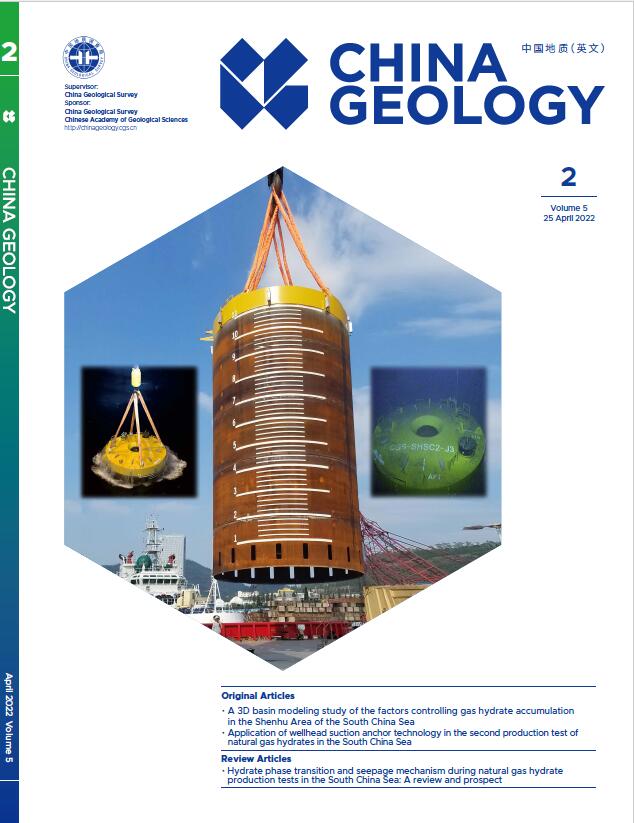



 DownLoad:
DownLoad:


